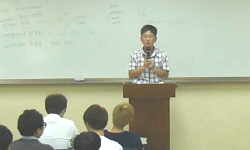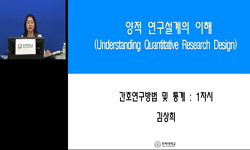Purpose : Vibration of the vocal cords is an essential part of voice production. A method for quantifying vibration is essential for the detection, diagnosis, and treatment of various voice disorders. The present study offers an automatic quantitative...
http://chineseinput.net/에서 pinyin(병음)방식으로 중국어를 변환할 수 있습니다.
변환된 중국어를 복사하여 사용하시면 됩니다.
- 中文 을 입력하시려면 zhongwen을 입력하시고 space를누르시면됩니다.
- 北京 을 입력하시려면 beijing을 입력하시고 space를 누르시면 됩니다.
https://www.riss.kr/link?id=A107138692
- 저자
- 발행기관
- 학술지명
- 권호사항
-
발행연도
2020
-
작성언어
English
- 주제어
-
KDC
379
-
등재정보
KCI등재
-
자료형태
학술저널
- 발행기관 URL
-
수록면
25-31(7쪽)
-
KCI 피인용횟수
0
- DOI식별코드
- 제공처
-
0
상세조회 -
0
다운로드
부가정보
다국어 초록 (Multilingual Abstract)
Purpose : Vibration of the vocal cords is an essential part of voice production. A method for quantifying vibration is essential for the detection, diagnosis, and treatment of various voice disorders. The present study offers an automatic quantitative method to describe vibration properties and analyzes its clinical usefulness in evaluating pathological vocal cords via two-dimensional videokymography (2D VKG).
Methods : The proposed method is based on image processing, which combines an active contour model with a genetic algorithm to improve the accuracy of detection and processing speed. It can accurately extract the vibration wave in two-dimensional videokymograms. The extracted 2D VKG information can be automatically converted into objective values in terms of five parameters (fundamental frequency [F0], open quotient [OQ], closed quotient [CQ], phase symmetry index [PSI], and amplitude symmetry index [ASI]). We compared the recovery of the vocal cords in a 52-year-old male with acute laryngitis by performing 2D VKG at 1, 3, and 4 weeks.
Results : F0 was not measurable at 1 week. After 4 weeks, it could be measured (117.24 Hz) after vocal cord vibration was observed. CQ, which reflects the degree of vocal cord contact, increased from 38% to 44%, while OQ decreased from 62% to 56%. PSI, which shows the regularity of the vocal cords, decreased from 0.148 to 0.72, while ASI decreased from 0.175 to 0.081.
Conclusions : The method used in this study allows easy analysis of vibratory parameters and quantifies mucosal wave parameters of vocal cord vibrations. Presenting the state of vocal cord vibration as a numerical value may increase clinical utility, as it is possible to compare the recovery of the vocal cords objectively.
참고문헌 (Reference)
1 김재옥, "반폐쇄성도훈련의 주관적 음성평가에 대한 메타분석" 한국언어치료학회 28 (28): 1-11, 2019
2 Kim, G. H., "Voice recovery in a patient with inhaled laryngeal burns" 31 (31): 55-, 2019
3 Benninger, M. S., "Vocal fold scarring : Current concepts and management" 115 (115): 474-482, 1996
4 Jan G. Švec, "Videokymography: High-speed line scanning of vocal fold vibration" Elsevier BV 10 (10): 201-205, 1996
5 Manfredi, C., "Videokymographic image processing: Objective parameters and user-friendly interface" 7 (7): 192-201, 2012
6 Kim, G. H., "Usefulness of two-dimensional digital kymography in patients with vocal fold scarring" 33 (33): 906-914, 2019
7 Doellinger, M., "The next step in voice assessment : High-speed digital endoscopy and objective evaluation" 4 (4): 101-111, 2009
8 Wang, S. G., "The first application of the two-dimensional scanning videokymography in excised canine larynx model" 30 (30): 1-4, 2016
9 Dailey, S. H., "The evaluation of benign glottic lesions: Rigid telescopic stroboscopy versus suspension microlaryngoscopy" 21 (21): 112-118, 2007
10 Deliyski, D. D., "State of the art laryngeal imaging: Research and clinical implications" 18 (18): 147-, 2010
1 김재옥, "반폐쇄성도훈련의 주관적 음성평가에 대한 메타분석" 한국언어치료학회 28 (28): 1-11, 2019
2 Kim, G. H., "Voice recovery in a patient with inhaled laryngeal burns" 31 (31): 55-, 2019
3 Benninger, M. S., "Vocal fold scarring : Current concepts and management" 115 (115): 474-482, 1996
4 Jan G. Švec, "Videokymography: High-speed line scanning of vocal fold vibration" Elsevier BV 10 (10): 201-205, 1996
5 Manfredi, C., "Videokymographic image processing: Objective parameters and user-friendly interface" 7 (7): 192-201, 2012
6 Kim, G. H., "Usefulness of two-dimensional digital kymography in patients with vocal fold scarring" 33 (33): 906-914, 2019
7 Doellinger, M., "The next step in voice assessment : High-speed digital endoscopy and objective evaluation" 4 (4): 101-111, 2009
8 Wang, S. G., "The first application of the two-dimensional scanning videokymography in excised canine larynx model" 30 (30): 1-4, 2016
9 Dailey, S. H., "The evaluation of benign glottic lesions: Rigid telescopic stroboscopy versus suspension microlaryngoscopy" 21 (21): 112-118, 2007
10 Deliyski, D. D., "State of the art laryngeal imaging: Research and clinical implications" 18 (18): 147-, 2010
11 Youngtae Park, "Shape-resolving local thresholding for object detection" Elsevier BV 22 (22): 883-890, 2001
12 Kang, D. H., "Real-time simultaneous DKG and 2D DKG using high-speed digital camera" 31 (31): 247E1-247E7, 2017
13 Kim, G. H., "Real-time dual visualization of two different modalities for the evaluation of vocal fold vibration–Laryngeal videoendoscopy and 2D scanning videokymography: Preliminary report" 44 (44): 174-181, 2017
14 Bohr, C., "Quantitative analysis of organic vocal fold pathologies in females by high‐speed endoscopy" 123 (123): 1686-1693, 2013
15 Yu, P., "Objective voice analysis for dysphonic patients: A multiparametric protocol including acoustic and aerodynamic measurements" 15 (15): 529-542, 2001
16 Inwald, E. C., "Multiparametric analysis of vocal fold vibrations in healthy and disordered voices in high-speed imaging" 25 (25): 576-590, 2011
17 Park, H. J., "Imaging and analysis of human vocal fold vibration using two-dimensional (2D) scanning videokymography" 30 (30): 345-353, 2016
18 Schutte, H. K., "First results of clinical application of videokymography" 108 (108): 1206-1210, 1998
19 Bae, I. H., "Efficacy of two-dimensional scanning digital kymography in evaluation of atrophic vocal folds" 33 (33): 554-560, 2019
20 Hamerly, J. R., "Detection and discrimination of blur in edges and lines" 71 (71): 448-452, 1981
21 Mehta, D. D., "Commentary on why laryngeal stroboscopy really works: Clarifying misconceptions surrounding Talbot’s law and the persistence of vision" 53 (53): 1263-1267, 2010
22 Lohscheller, J., "Clinically evaluated procedure for the reconstruction of vocal fold vibrations from endoscopic digital high-speed videos" 11 (11): 400-413, 2007
23 Lee, J. C., "Clinical practicability of a newly developed real-time digital kymographic system" 33 (33): 346-351, 2019
24 Deliyski, D. D., "Clinical implementation of laryngeal high-speed videoendoscopy:Challenges and evolution" 60 (60): 33-44, 2008
25 Bae, I. H., "Clinical application of two-dimensional scanning digital kymography in discrimination of diplophonia" 62 (62): 3643-3654, 2019
26 Yan, Y., "Analysis of vocal-fold vibrations from high-speed laryngeal images using a Hilbert transform-based methodology" 19 (19): 161-175, 2005
27 Qiu, Q., "An automatic method to quantify the vibration properties of human vocal folds via videokymography" 55 (55): 128-136, 2003
28 Jiang, J. J., "An automatic method to quantify mucosal waves via videokymography" 118 (118): 1504-1510, 2008
29 Andrade-Miranda, G., "An automatic method to detect and track the glottal gap from high speed videoendoscopic images" 14 (14): 100-, 2015
30 Yumoto, E., "Aerodynamics, voice quality, and laryngeal image analysis of normal and pathologic voices" 12 (12): 166-173, 2004
31 한단비, "ADSV와 MDVP 음성 파라미터 간의 상관연구" 한국언어치료학회 28 (28): 65-72, 2019
32 Sahoo, P. K., "A thresholding method based on two-dimensional Renyi's entropy" 37 (37): 1149-1161, 2004
33 Švec, J. G., "A subharmonic vibratory pattern in normal vocal folds" 39 (39): 135-143, 1996
34 Wang, S. G., "A new videokymography system for evaluation of the vibration pattern of entire vocal folds" 43 (43): 315-321, 2016
35 Dillencourt, M. B., "A general approach to connected-component labeling for arbitrary image representations" 39 (39): 253-280, 1992
동일학술지(권/호) 다른 논문
-
텍스트마이닝과 문헌고찰을 통한 청소년기 말더듬 연구 트랜드 분석
- 한국언어치료학회
- 김효정(Hyo Jung Kim)
- 2020
- KCI등재
-
A Study of Disfluency Characteristics According to Auditory Feedback Condition
- 한국언어치료학회
- Hyun Jin Chang(장현진)
- 2020
- KCI등재
-
- 한국언어치료학회
- Chorong Oh
- 2020
- KCI등재
-
언어치료 임상 현장에서의 이야기 평가와 중재 현황 및 언어재활사의 인식과 요구도 설문 조사
- 한국언어치료학회
- 김지혜(Ji Hye Kim)
- 2020
- KCI등재
분석정보
인용정보 인용지수 설명보기
학술지 이력
| 연월일 | 이력구분 | 이력상세 | 등재구분 |
|---|---|---|---|
| 2027 | 평가예정 | 재인증평가 신청대상 (재인증) | |
| 2021-01-01 | 평가 | 등재학술지 유지 (재인증) |  |
| 2018-01-01 | 평가 | 등재학술지 유지 (등재유지) |  |
| 2017-01-16 | 학회명변경 | 영문명 : Korean Speech, Language & Hearing Association(Ksha) -> Korean Speech- Language & Hearing Association(KSHA) |  |
| 2015-10-19 | 학술지명변경 | 외국어명 : Journal of speech & hearing disorders -> Journal of speech-language & hearing disorders |  |
| 2015-01-01 | 평가 | 등재학술지 유지 (등재유지) |  |
| 2011-01-01 | 평가 | 등재학술지 유지 (등재유지) |  |
| 2009-01-01 | 평가 | 등재학술지 유지 (등재유지) |  |
| 2006-07-14 | 학술지명변경 | 외국어명 : 미등록 -> Journal of speech & hearing disorders |  |
| 2006-01-01 | 평가 | 등재학술지 선정 (등재후보2차) |  |
| 2005-05-30 | 학술지등록 | 한글명 : 언어치료연구외국어명 : 미등록 |  |
| 2005-01-01 | 평가 | 등재후보 1차 PASS (등재후보1차) |  |
| 2004-01-01 | 평가 | 등재후보학술지 유지 (등재후보1차) |  |
| 2002-07-01 | 평가 | 등재후보학술지 선정 (신규평가) |  |
학술지 인용정보
| 기준연도 | WOS-KCI 통합IF(2년) | KCIF(2년) | KCIF(3년) |
|---|---|---|---|
| 2016 | 1.11 | 1.11 | 1.23 |
| KCIF(4년) | KCIF(5년) | 중심성지수(3년) | 즉시성지수 |
| 1.15 | 1.08 | 1.804 | 0.33 |





 DBpia
DBpia






